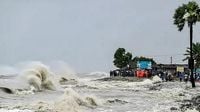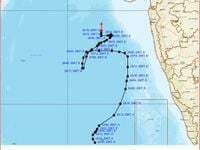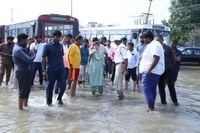As October 2025 draws to a close, large swathes of India are still grappling with the aftermath of Cyclone Montha, a severe weather event that, while now weakened, has left a trail of destruction, severe flooding, and ongoing weather alerts across multiple states. The India Meteorological Department (IMD) continues to issue warnings and updates as the remnant systems from Montha, along with other active depressions, bring heavy rainfall and disrupt daily life from Telangana in the south to West Bengal and Gujarat in the east and west.
The saga of Cyclone Montha began with its landfall near Narsapur, between Machilipatnam and Kalingapatnam, during the midnight hours of October 28-29, 2025. According to the IMD, the cyclone struck with wind speeds between 90 and 100 km/h, gusting up to 110 km/h, unleashing its fury on the Andhra Pradesh coast. The immediate aftermath was grim: two fatalities were reported, and the agricultural heartland suffered a devastating blow. The Economic Times reported that 38,000 hectares of standing crops and 138,000 hectares of horticulture crops were destroyed, while lakes overflowed, rivers swelled, and hundreds of residents had to be rescued from flooded areas as trees and power lines came crashing down.
But Montha’s impact didn’t end at the coastline. As the system moved inland, it gradually weakened—from a severe cyclonic storm to a cyclonic storm, then a deep depression, and finally, by October 30, to a well-marked low-pressure area over east Vidarbha and adjoining south Chhattisgarh. The IMD bulletin on October 30 stated, "The Depression [Remnant of Severe Cyclonic Storm 'Montha'] over south Chhattisgarh and adjoining Vidarbha moved north-northwestwards and weakened into a Well Marked Low Pressure Area over east Vidarbha and adjoining south Chhattisgarh at 0530 hrs IST of today."
Even as it lost strength, Montha’s remnants continued to wreak havoc. Telangana, in particular, bore the brunt of the storm’s lingering effects. The IMD issued a red alert for the state, warning of very heavy to extremely heavy rainfall, thunderstorms, lightning, and gusty winds of 40-50 km/h in districts such as Rajanna Sircilla, Karimnagar, Mahabubabad, Warangal, and Jangaon. Warangal alone recorded 91 mm of rainfall on October 29. Telangana’s Endowments and Forest Minister, Konda Surekha, described the dire situation to ANI: "Cyclone 'Montha' and heavy rainfall have caused heavy flooding in Telangana, particularly affecting colonies and roads. Despite efforts to evacuate, many residents remain stranded and refuse to leave their homes."
Flooding in Telangana led to widespread disruption. In some areas, traffic ground to a halt, especially in Hyderabad’s Habsiguda neighborhood, as waterlogged streets became impassable. The Bhadradri Kothagudem District Collector responded by declaring a holiday for all educational institutions on October 29, an effort to keep students and teachers safe amid the deluge.
Meanwhile, the IMD wasn’t just focused on Telangana. The weakened Montha system continued its northward march, threatening eastern Madhya Pradesh and north Chhattisgarh with further rainfall and the risk of flooding. The IMD’s forecast warned of heavy to very heavy rain—between 7 and 20 centimeters—in the north Bengal districts of Darjeeling, Kalimpong, Jalpaiguri, Alipurduar, and Cooch Behar on October 31. Malda, Uttar Dinajpur, and Dakshin Dinajpur were also expected to receive 7-11 centimeters of precipitation.
Looking ahead to November 1, the IMD cautioned that heavy rainfall would persist in Alipurduar and Cooch Behar. The hilly districts of Darjeeling and Kalimpong faced an added risk: landslides. "Landslides may occur in the hilly areas of Darjeeling and Kalimpong districts, owing to the downpour," the IMD bulletin stated. The south Bengal districts of Birbhum, Murshidabad, Paschim Bardhaman, and Purulia were also on alert for heavy rainfall through October 31, with lighter showers expected elsewhere in the region.
But if you thought Montha was the only weather system causing concern, think again. Another depression, this one over the east-central Arabian Sea, has been steadily moving westwards. As of 5:30 AM on October 30, the IMD reported it was centered near latitude 17.9°N and longitude 68.2°E—about 400 km southwest of Veraval, Gujarat, and 510 km west-southwest of Mumbai. The system was moving at 13 km/h and was expected to continue westward across the Arabian Sea for the next 36 hours. By 11:30 PM, it had edged slightly north, still threatening coastal regions.
Gujarat, Saurashtra, and Kutch were among the regions bracing for impact. The IMD forecast called for light to moderate rain, with isolated heavy to very heavy showers and thunderstorms, lightning, and coastal wind speeds up to 65 km/h until November 1. The orange alert issued for Bihar, Saurashtra, and Kutch underscored the seriousness of the situation, with authorities urging residents in low-lying areas to remain vigilant against waterlogging and localized flooding.
The northeast, too, was not spared. The IMD predicted that Arunachal Pradesh, Assam, Meghalaya, Nagaland, Manipur, Mizoram, and Tripura would experience thunderstorms and heavy rainfall from October 31 to November 1, as moist winds from the Bay of Bengal interacted with existing weather systems. Residents in landslide-prone areas, especially in Arunachal Pradesh and Meghalaya, were advised to avoid unnecessary travel and stay alert for sudden changes in weather conditions.
In eastern Uttar Pradesh, light to moderate rain and isolated heavy showers were forecast for October 31, while in Pune, the weather was expected to improve from November 1, with a return to clearer skies, slightly higher temperatures, and no weather warnings in place.
Throughout this period, the IMD’s persistent warnings and updates have been crucial in helping authorities and residents prepare for and respond to the evolving situation. The agency’s seven-day forecast for affected regions has enabled local governments to take pre-emptive measures, from evacuations and school closures to deploying rescue teams and issuing advisories for travelers and farmers.
Despite the weakening of Cyclone Montha, its aftershocks are still being felt. From the devastation in Andhra Pradesh’s farmlands to the flooded streets of Telangana and the landslide risks in Bengal’s hills, the storm has served as a stark reminder of the power of nature—and the importance of heeding meteorological warnings. As November arrives, many communities are left picking up the pieces and hoping for calmer skies ahead.


